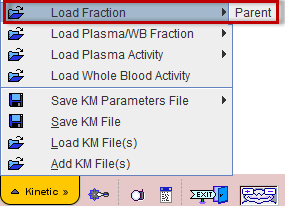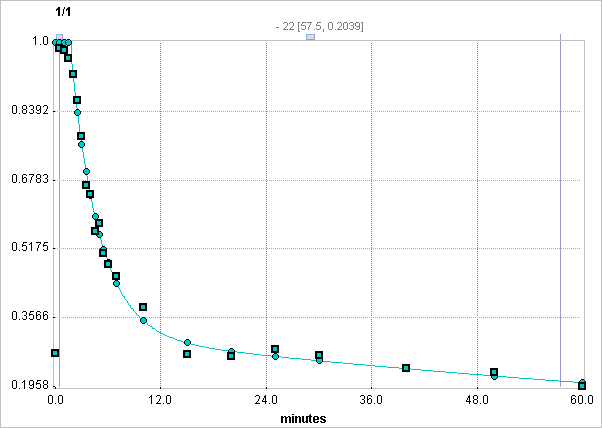The sequential steps for converting blood measurements to an input curve are explained in a dedicated section. The current parent fraction model serves for converting a plasma activity curve into an input curve (authentic, unchanged tracer in plasma).
The 3-Exponential model assumes that the concentration ratio of authentic tracer to total tracer in plasma has been determined at certain times during the acquisition and loaded with the Load Fraction entry in the menu.

Operational Model Curve
The general 3-Exponential model for the parent fraction has the following functional form

The calculated fraction is multiplied with fp, the free fraction of authentic tracer in plasma, i.e. the fraction of tracer not bound to plasma proteins.
The fraction calculation assumes negligible metabolites before a Begin time, and therefore remains constant at 1. From Begin on it decreases as a sum of three exponentials with halftimes T1, T2 and T3. Note that the calculated fractions are restricted to the physiologic [0,1] value range.

Parameter Fitting
The free fraction fp is an input parameter which has no impact on fitting the model curve to the fraction data. The default for fp is 1 as it is experimentally difficult to measure.
The model supports the fitting of the parameters Begin, Amplitude 1, 2, 3 (=A1, A2, A3) and Halftime 1, 2, 3 (=T1, T2, T3). All data samples are considered in the fitting process irrespective of Begin. The three Amplitude parameters are restricted to the range [0,1] per default.
Use without Measured Parent Fraction
The 3-Exponential parent fraction model can be applied even if no parent fraction measurements were loaded. In this case the user has to specify a parameter set which establishes a representative metabolite correction for the used tracer.